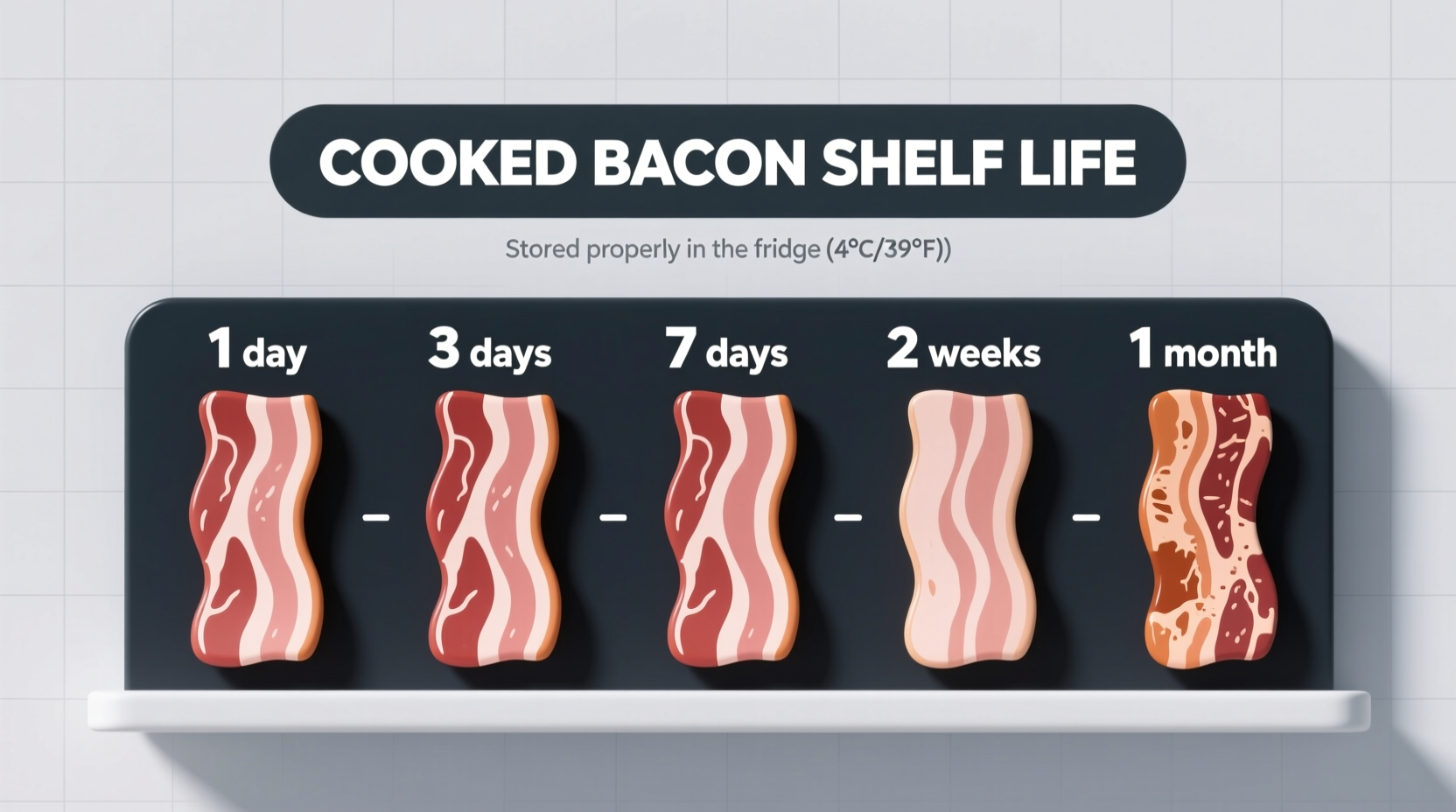Your Complete Guide to Cooked Bacon Storage Safety
Leftover bacon shouldn't become a food safety gamble. Understanding proper storage timelines prevents waste while protecting your health. This guide delivers science-backed recommendations from food safety authorities so you can enjoy your crispy leftovers with confidence.
Why Bacon Storage Time Matters More Than You Think
Cooked bacon contains moisture and fat that create ideal conditions for bacterial growth when stored improperly. Unlike raw meat, cooked bacon has already undergone the Maillard reaction, altering its protein structure and making it more susceptible to spoilage. The USDA Food Safety and Inspection Service emphasizes that cooked meats require more careful handling than their raw counterparts because the cooking process eliminates competing bacteria, allowing pathogens like Staphylococcus aureus to multiply rapidly if temperature guidelines aren't followed.
| Storage Method | Optimal Duration | Safety Temperature | Quality Expectation |
|---|---|---|---|
| Refrigerator (airtight container) | 4-5 days | ≤40°F (4°C) | Retains crispness when reheated properly |
| Freezer (vacuum-sealed) | 3 months | 0°F (-18°C) | Near-fresh quality when thawed correctly |
| Room temperature | 2 hours maximum | >40°F (4°C) | Rapid quality deterioration |
Step-by-Step: Maximizing Your Cooked Bacon's Shelf Life
Immediate Post-Cooking Protocol
The critical window begins the moment bacon leaves the pan. Follow these steps within 2 hours of cooking:
- Cool rapidly - Spread strips in a single layer on a wire rack to dissipate heat faster than stacking
- Remove excess grease - Blot with paper towels to reduce moisture that accelerates spoilage
- Seal properly - Use airtight containers with minimal air space or vacuum sealing for freezer storage

Refrigeration Best Practices
Not all refrigerator storage methods yield equal results. The USDA recommends these specific techniques:
- Store in the main compartment, not the door where temperature fluctuates
- Place container toward the back where temperatures remain most consistent
- Use glass containers which maintain temperature better than plastic
- Label containers with cooking date using the "first in, first out" principle
Freezing for Long-Term Preservation
For meal prep enthusiasts, freezing cooked bacon requires special attention:
- Flash-freeze individual strips on a parchment-lined tray before transferring to bags
- Remove as much air as possible from storage bags to prevent freezer burn
- Portion into single-serving quantities to avoid repeated thawing cycles
- Use within 3 months for optimal texture and flavor retention
When Bacon Crosses the Safety Line: Spoilage Indicators
Don't rely solely on expiration dates. The FDA advises checking these critical warning signs:
- Texture changes - Slimy film or excessive softness indicates bacterial growth
- Odor development - Sour, fishy, or ammonia-like smells mean spoilage
- Visual cues - Discoloration beyond normal browning (green, gray, or black spots)
- Mold presence - Any visible mold means immediate disposal (don't attempt to cut away)
Remember: "When in doubt, throw it out" isn't just a saying—it's a food safety imperative. The USDA confirms that harmful bacteria like Listeria can grow without visible signs in improperly stored cooked meats.
Reheating Leftover Bacon Safely
Proper reheating restores crispness while ensuring safety:
- Oven method - 375°F for 5-8 minutes on a wire rack over baking sheet
- Air fryer - 350°F for 3-4 minutes (ideal for maintaining crisp texture)
- Skillet approach - Medium heat with occasional flipping until internal temperature reaches 165°F
Never microwave bacon if maintaining crispness is important—this method creates uneven heating that can leave cold spots where bacteria survive. The Food Safety Inspection Service requires all reheated cooked meats to reach 165°F internally to eliminate potential pathogens.
Special Circumstances: When Standard Guidelines Don't Apply
Certain situations require modified storage approaches:
- Bacon in dishes - Casseroles or salads containing bacon follow the shortest shelf life of any ingredient (typically 3-4 days)
- Travel conditions - In coolers, keep below 40°F with ice packs for no more than 24 hours
- Power outages - Refrigerated bacon remains safe for 4 hours without power if door remains closed
Expert-Verified Storage Timeline
Based on USDA FoodKeeper app data and FDA guidelines, here's the precise timeline for cooked bacon:
- Day 1-2: Peak quality - maintains near-fresh crispness when reheated
- Day 3-4: Good quality - slight moisture absorption but still safe
- Day 5: Final safe day - quality noticeably declines but still edible if properly stored
- Day 6+: High risk - bacterial growth exceeds safety thresholds even if no visible spoilage











 浙公网安备
33010002000092号
浙公网安备
33010002000092号 浙B2-20120091-4
浙B2-20120091-4